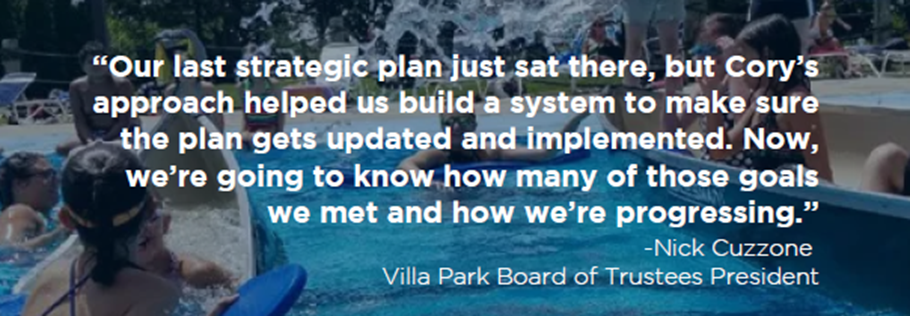There’s a reason city managers say you need to plan your work and work your plan. Without a plan, cities open themselves up to inconsistencies in policies, wasted resources, reactive decision-making, and missed opportunities. McMinnville Profile Population: 13,681 Operating Budget: $27 million Government Structure: Mayor-Aldermanic Services: Community survey, focus groups, strategic planning Learn how the City of McMinnville used CP2 Consulting’s deliberate, methodological, and analytical process to develop a strategic plan that will guide its budget and decision-making process into the future. “I’d recommend any community undertake
“Cory’s good about reminding us to honor the process and the work, and this plan creates a clear process. We know our priorities and what we need to do to make progress, and this will move us toward becoming a better community.” -Matt Harline, Village Manager, Villa Park, IL Read the case study here:
“The most important planning tool a nonprofit has is its strategic plan,” says Voluntary Action Center of Northern Illinois CEO Nate Kloster.
Rochelle City Manager Jeff Fiegenschuh saw an opportunity to set the tone and foster a reinvigorated, positive culture.
If you want to go fast, go alone. If you want to go far, go together. Police: Officer Partners Standing Together The value of public input is well-documented for identifying short- and long-term goals. It provides insight into the complex—and often competing—interests, values, and priorities city leaders must juggle. While this is an important stakeholder group to involve in the strategic planning process, it’s not the only one. Department managers, committee and commission members, and your front-line workers have knowledge that can be instrumental
The role of the public in municipal strategic planning has evolved from old-school, top-down processes to today’s highly collaborative approach. Community input is critical to municipal planning, and while public meetings and focus groups provide great venues for in-person comment, they can fall short. In-person collaboration often omits swaths of residents who can add value—caretakers, single and working parents, night-shift workers (nurses and hospital staff, for example), gig workers, underserved communities, people without reliable transportation, and more. Public leaders must extend every
Survey data is an important component of research methodologies, especially for municipal planning. However, survey fatigue and constraints around open-ended questions mean the insights generated often lead to one big question, “Why?” Why did respondents say this was an issue? Why do residents over the age of 45 see this as an issue, while younger residents do not? Small-group discussions around specific questions and topics can help decision-makers see the “Why?” behind their survey data. Although these groups are widely used by





